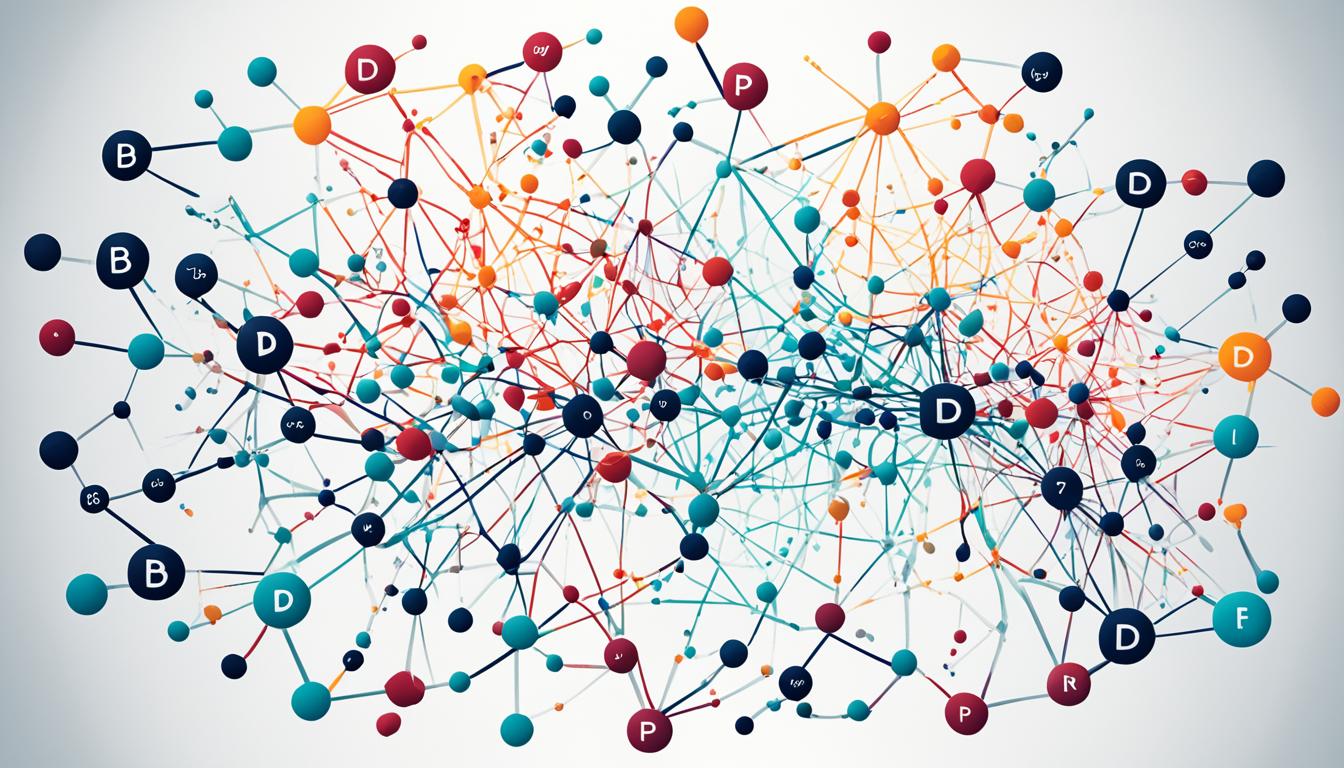Approximately 5.9% of adults in the United States are affected by Borderline Personality Disorder (BPD) or Narcissistic Personality Disorder (NPD). These mental health conditions can significantly impact personal relationships, resulting in dysfunctional communication and emotional distress. If you are dealing with a narcissistic partner or in a relationship with someone displaying symptoms of borderline personality disorder, it is important to comprehend the intricacies of these disorders and learn effective strategies for handling these difficult circumstances.
Key Takeaways:
- Relationships with individuals with BPD and NPD can be intense and unhealthy.
- BPD is characterized by instability in interpersonal relationships, mood, and self-image.
- NPD is characterized by a grandiose sense of self, lack of empathy, and a need for admiration.
- Understanding the dynamics and seeking appropriate therapy and support is crucial for navigating these relationships.
- Self-care and healing are essential in breaking free from toxic relationship patterns.
Understanding Borderline Personality Disorder
BPD, or Borderline Personality Disorder, is a complex mental health condition characterized by dysfunctional interpersonal relationships, mood instability, self-injurious behavior, fear of abandonment, and maladaptive coping behaviors. People with BPD often struggle to return to their emotional baseline and frequently experience intense emotional reactions to triggers in their environment.
While the exact cause of BPD is still unknown, experts believe it is influenced by a combination of genetic factors, childhood abuse, neglect, and separation from loved ones. These experiences can contribute to the development of BPD traits and shape an individual’s perspective on relationships and self-identity.
It is important to understand that BPD is different from Narcissistic Personality Disorder (NPD), although the two can sometimes coexist. BPD is characterized by unstable self-image and relationships, while NPD is associated with a grandiose sense of self, lack of empathy, and a need for admiration.
By gaining a deeper understanding of the unique challenges faced by individuals with BPD, we can navigate relationships with greater empathy, compassion, and effectiveness in managing the specific dynamics that may arise.
BPD Symptoms and Emotional Instability
Individuals with BPD often experience intense emotional storms that can be triggered by seemingly minor events or perceived abandonment. These emotional reactions can last for extended periods and make it difficult for individuals with BPD to regulate their emotions and return to a stable state.
Common symptoms of BPD include:
- Unstable and intense interpersonal relationships
- Chronic feelings of emptiness
- Fear of abandonment and frantic efforts to avoid it
- Impulsive and self-destructive behaviors, such as self-harm
- Distinct shifts in self-image and identity
Impact of Childhood Experiences
Childhood experiences play a significant role in the development of BPD. Individuals who have experienced childhood trauma, such as abuse or neglect, are more likely to develop BPD later in life. The absence of stable and nurturing relationships during childhood can contribute to difficulties in forming healthy, secure attachments as adults.
Additionally, separation from loved ones, such as through foster care or adoption, can also contribute to the development of BPD traits. The lack of consistent care and support can lead individuals to develop maladaptive coping mechanisms and an intense fear of abandonment.
“Understanding the root causes of BPD, including childhood trauma and abandonment issues, allows us to approach individuals with empathy and provide appropriate support.
Effective Communication Strategies
When navigating a relationship with someone who has BPD, it is important to emphasize open and honest communication. Active listening, validating their emotions, and expressing empathy can foster a sense of trust and safety within the relationship.
Setting clear boundaries and regularly checking in to ensure both parties’ needs are being met can also help manage the unique dynamics in a relationship with someone who has BPD. Effective communication strategies can contribute to building a healthier and more understanding relationship.
| Effective Communication Strategies in BPD Relationships |
|---|
| Active listening and validation |
| Expressing empathy and understanding |
| Setting clear and healthy boundaries |
| Regularly checking in on emotions and needs |
By understanding the complexities of Borderline Personality Disorder and implementing effective strategies for communication and boundary-setting, we can foster healthier and more fulfilling relationships with individuals who have BPD.
Understanding Narcissistic Personality Disorder
Narcissistic Personality Disorder (NPD) is a psychological condition characterized by self-centeredness, feelings of grandiosity, a desire for admiration, and a lack of empathy. Individuals with NPD often prioritize their own needs and desires over the feelings and well-being of others.
Narcissism typically develops in childhood as a result of overexaggeration of positive qualities and superficial engagement by parents. Children who are praised excessively and constantly told they are special may develop narcissistic tendencies as they grow older.
It’s important to note that narcissism occurs on a spectrum, with some individuals displaying narcissistic traits without meeting the full criteria for NPD. However, when these traits become significantly impairing and cause distress to the individual or those around them, a diagnosis of NPD may be warranted.
Dealing with a borderline narcissist partner can be challenging, as their self-centeredness often leads to difficulties in communication and setting boundaries. It is crucial for people in relationships with narcissistic individuals to prioritize self-care and establish healthy boundaries to protect their own well-being.
It’s important to remember that you are not responsible for the narcissistic behavior of your partner. It is not your fault, and you deserve to be treated with respect and empathy.
When communicating with a borderline narcissist partner, it can be helpful to use “I” statements to express your feelings and needs. This can nurture a more constructive dialogue and prevent the conversation from escalating into conflict.
In addition, setting clear boundaries is essential in managing a relationship with a narcissist. Clearly communicate your limits and expectations, and be prepared to enforce these boundaries if they are crossed.
Self-care is crucial in navigating a relationship with a borderline narcissist. Take time for yourself, engage in activities that bring you joy and relaxation, and seek support from friends, family, or therapists who specialize in working with individuals in toxic relationships.
Recognizing the toxic relationship patterns and prioritizing self-care can help individuals cope with the challenges of being in a relationship with a borderline narcissist. By taking care of ourselves, we can maintain our emotional well-being and make informed decisions about the future of the relationship.

Signs of a Narcissistic Relationship
| Signs | Description |
|---|---|
| Constant need for admiration | A narcissistic partner may demand constant praise and recognition, seeking validation from others to maintain their self-esteem. |
| Lack of empathy | Narcissists often have difficulty understanding and empathizing with the emotions and needs of others, prioritizing their own desires over those of their partner. |
| Manipulative behavior | Narcissists may employ manipulative tactics to maintain control and power in the relationship, often using guilt, gaslighting, and emotional coercion. |
| Violation of boundaries | Narcissistic individuals frequently disregard and overstep the boundaries set by their partner, not considering or respecting their needs and limits. |
| Emotional volatility | Narcissists can exhibit dramatic mood swings, shifting from extreme charm and affection one moment to anger and hostility the next. |
Relationship Dynamics Between People with BPD and NPD
Relationships between individuals with Borderline Personality Disorder (BPD) and Narcissistic Personality Disorder (NPD) can be tumultuous. The BPD sufferer may be attracted to the confidence and self-assured nature of the narcissist. However, this dynamic often leads to emotional abuse and can trigger the BPD sufferer’s fear of abandonment.
Unfortunately, the narcissist in the relationship tends to disregard boundaries and feelings of the BPD individual, using them solely for validation and attention. This unhealthy dynamic not only perpetuates emotional abuse but also feeds into the narcissist’s desire for constant attention.
Emotional abuse in relationships is a common occurrence in BPD/NPD relationships, as the narcissist manipulates and controls the BPD individual to meet their own selfish needs. This type of abuse can have long-lasting effects on the BPD individual’s self-esteem and mental well-being.
Setting boundaries with a narcissistic partner is crucial for the BPD individual’s healing and overall well-being. By establishing clear boundaries, the BPD individual can protect themselves from further emotional abuse and regain a sense of control in the relationship.
Recovering from a relationship with a borderline narcissist requires recognizing the abusive patterns and taking steps to prioritize your own healing and personal growth.
Recovering from a relationship with a borderline narcissist is a challenging journey that requires time and self-care. It is important for the BPD sufferer to seek support from friends, family, or a therapist who specializes in healing from a toxic relationship.
The Impact of Emotional Abuse in BPD/NPD Relationships
Emotional abuse in BPD/NPD relationships can have a profound impact on the BPD individual’s mental health. Constant criticism, manipulation, and disregard for boundaries can take a toll on their self-esteem, leading to feelings of worthlessness, anxiety, and depression.
Moreover, the BPD individual’s fear of abandonment is often triggered, as the narcissistic partner may use threats of leaving or actual abandonment as a means of control. This emotional rollercoaster exacerbates the BPD individual’s emotional instability and can lead to further deterioration of their mental well-being.
However, it is important to remember that healing is possible. By acknowledging the emotional abuse and taking steps to regain control of their life, individuals can begin the journey towards healing and recovering from a relationship with a borderline narcissist.
| Effects of Emotional Abuse in BPD/NPD Relationships | Effects on the BPD Individual |
|---|---|
| 1. Low self-esteem and self-worth | 1. Feelings of worthlessness and inadequacy |
| 2. Anxiety and depression | 2. Increased emotional instability |
| 3. Fear of abandonment | 3. Heightened sensitivity to rejection |
| 4. Isolation and social withdrawal | 4. Deterioration of interpersonal relationships |
Healing from a toxic relationship requires time, self-reflection, and support. By prioritizing self-care and seeking professional help, individuals can overcome the emotional wounds inflicted by a borderline narcissistic partner and embark on a journey of personal growth and recovery.

The Unique Challenges in BPD/NPD Relationships
Managing a relationship with a narcissist and coping with a partner with borderline personality disorder can present unique challenges. Both individuals in the relationship face their own struggles, which can contribute to a dynamic filled with intense emotions, power struggles, and manipulation.
For the individual with borderline personality disorder (BPD), emotional dysregulation and fear of abandonment can be constant battles. The fear of being left alone can lead to clinginess or constant pursuit of the narcissistic partner. These behaviors may provide a temporary sense of security but ultimately contribute to the toxic dynamics of the relationship.
On the other hand, the narcissistic partner may struggle with a constant need for control and admiration. Their grandiose sense of self can lead to manipulative behaviors aimed at satisfying their own ego. This can manifest as gaslighting, belittling, or invalidating the emotions and experiences of the BPD individual.
Healing from a relationship with a narcissist and navigating a toxic relationship requires therapy to address the underlying trauma that contributes to these behaviors. Breaking the cycle of power struggles and manipulation is essential for both parties to achieve personal growth and establish healthier relationship dynamics.
“The key to healing from a relationship with a narcissist is understanding the root causes of these toxic behaviors and providing a safe space for both individuals to heal and grow.”
In therapy, the BPD individual can learn coping strategies to regulate their emotions and develop a sense of self-worth and independence. Learning to set boundaries and communicate effectively can help establish a healthier relationship dynamic. Additionally, therapy can help address the fear of abandonment and develop healthier strategies for dealing with triggers.
For the narcissistic partner, therapy can provide opportunities for self-reflection and personal growth. Exploring the underlying insecurities and developing empathy and understanding for the BPD partner’s needs are crucial steps towards breaking the cycle of manipulation and control.
Ultimately, the unique challenges in BPD/NPD relationships require a commitment to self-care from both individuals. Establishing boundaries, engaging in self-compassion, and prioritizing one’s own well-being are essential for navigating and healing from a toxic relationship.

| Challenges in BPD/NPD Relationships | Coping Strategies |
|---|---|
| Emotional dysregulation and fear of abandonment | Therapy to develop coping strategies for emotional regulation and address fear of abandonment. Setting boundaries and practicing self-care. |
| Need for control and admiration | Therapy to explore underlying insecurities, develop empathy, and establish healthier patterns of behavior. |
| Power struggles and manipulation | Learning effective communication, setting boundaries, and developing healthier relationship dynamics through therapy. |
| Underlying trauma | Trauma-informed therapy to address the root causes of toxic behaviors and facilitate healing and personal growth. |
The Importance of Trauma-Informed Therapy
In therapy, it is crucial to employ approaches that address the complex issues present in BPD/NPD relationships. Traditional therapy methods may not fully capture the intricacies and unique dynamics of these relationships. This is where trauma-informed therapy plays a significant role.
Trauma-informed therapy recognizes that childhood trauma often underlies the development of personality disorders such as BPD and NPD. By focusing on understanding and healing these past traumas, therapists can help individuals break free from toxic relationship patterns and maladaptive coping strategies.
This type of therapeutic intervention is vital, not only for the individuals involved, but also to prevent the perpetuation of destructive behaviors in future generations. By addressing childhood trauma and promoting healthier relationship patterns, we can create environments that support growth and healing, reducing the risk of children growing up in chaotic and harmful environments.

Why Trauma-Informed Therapy Matters
Trauma-informed therapy provides a holistic and compassionate approach to mental health treatment. By recognizing the impact of childhood trauma on the development of BPD and NPD, therapists can tailor their interventions to address the root causes of these disorders.
“Trauma-informed therapy helps us understand that BPD and NPD are not simply ‘bad personality traits.’ They are often the result of deep-seated wounds that require healing and understanding.” – Dr. Emily Adams
By creating a safe and supportive therapeutic environment, individuals can explore and process their traumatic experiences. This allows them to gain insight into how these experiences have shaped their behaviors and relationships.
Through trauma-informed therapy, individuals can acquire the coping skills and emotional regulation techniques needed to manage their BPD or NPD symptoms effectively. By addressing the underlying trauma, therapy can help individuals develop healthier ways of relating to themselves and others, fostering empathy and promoting personal growth.
The Role of Childhood Trauma in BPD and NPD
Childhood trauma, such as physical or emotional abuse, neglect, or the loss of a caregiver, can significantly impact the development of BPD and NPD. These traumatic experiences often distort a person’s sense of self, leading to difficulties in forming and maintaining healthy relationships.
When trauma occurs during critical periods of childhood development, it can disrupt the formation of secure attachments and impact a person’s ability to regulate their emotions. These disruptions can manifest as the symptoms characteristic of BPD and NPD.
By understanding the role of childhood trauma, therapists can help individuals navigate the complex emotions and reactions associated with BPD and NPD. This understanding allows for targeted therapeutic interventions that address both the symptoms and the underlying trauma.
| Childhood Trauma | Impact on BPD/NPD |
|---|---|
| Physical abuse | Difficulty forming trust in relationships and regulating emotions |
| Emotional neglect | Low self-worth and feelings of emptiness |
| Loss of a caregiver | Fear of abandonment and unstable sense of self |
Taking a trauma-informed approach to therapy ensures that these underlying childhood traumas are addressed, providing individuals with the necessary tools to heal and recover from BPD and NPD.
Personal Stories and Experiences
Personal stories and experiences play a crucial role in understanding the challenges and complexities of relationships involving Borderline Personality Disorder (BPD) and Narcissistic Personality Disorder (NPD). These firsthand accounts offer valuable insights into the emotional toll, manipulation, and power dynamics that are often at play. By sharing their stories, individuals in these relationships provide a sense of validation and support for others who may be going through similar struggles.
“I remember feeling like I was constantly walking on eggshells. Any little thing could set them off, and their anger was always intense and directed towards me. It was exhausting to constantly try to fulfill their needs while neglecting my own.”
— Sarah, survivor of a BPD/NPD relationship
These personal stories often showcase the rollercoaster ride of emotions that accompanies BPD/NPD relationships. They highlight the intense highs and lows, the fear of abandonment, and the overwhelming need for validation and control. Through these narratives, individuals gain a deeper understanding of the dynamics at play and can identify with the struggles faced by others.
“Reading about others who have been through similar situations helped me realize that I wasn’t alone. It gave me the strength to seek help and make changes in my own life.” – Mark, finding support through personal stories
What We Can Learn from Personal Stories:
- Recognizing the signs of a BPD/NPD relationship
- Understanding the impact of emotional manipulation
- Identifying personal boundaries and red flags
- Gaining insights into effective coping strategies
- Discovering the power of therapy and support networks
The experiences shared by individuals who have navigated BPD/NPD relationships offer hope, inspiration, and practical advice for those seeking guidance. By learning from their stories, we can develop strategies for self-care, establish healthier boundaries, and ultimately break free from the cycle of toxic relationships.
| Personal Story | Key Takeaways |
|---|---|
| Sarah’s Journey | – Importance of self-care – Recognizing the signs of emotional abuse – Seeking therapy for healing and growth |
| Mark’s Story | – Understanding the impact of manipulation – Building a support system – Celebrating personal growth and resilience |
| Emily’s Experience | – Transforming pain into personal empowerment – Setting boundaries and prioritizing self-worth – Finding love and happiness after a toxic relationship |
These personal stories remind us that, no matter how challenging BPD/NPD relationships may be, there is always hope for healing and growth. By sharing their experiences, these individuals provide a beacon of light for others seeking their own paths to recovery. Together, we can break the cycle of toxic relationships and create a better future for ourselves.

Seeking Help and Support
Are you in a toxic relationship with someone who has Borderline Personality Disorder (BPD) or Narcissistic Personality Disorder (NPD)? It’s essential to seek help and support to navigate the challenges that come with these complex dynamics.
There are several options available to individuals in BPD/NPD relationships:
- Individual Therapy: Working with a therapist who specializes in trauma-informed therapy can provide the necessary guidance and tools to navigate the challenges of a toxic relationship. They can help you develop coping strategies, set boundaries, and work through any underlying trauma that may contribute to the relationship dynamics.
- Couples Therapy: Couples therapy can be a valuable resource for both partners in a BPD/NPD relationship. It offers a safe space to openly communicate, address conflicts, and work towards healthier patterns of interaction. A skilled therapist can facilitate productive dialogue, encourage empathy and understanding, and assist in building a healthier foundation for the relationship.
- Support Groups: Connecting with others who have similar experiences can provide validation, understanding, and a sense of community. Support groups, whether in-person or online, offer a safe space to share struggles, exchange advice, and gain support from people who truly understand what you’re going through.
“Seeking help and support is not a sign of weakness, but a courageous step towards healing and reclaiming your wellbeing.”
In addition to professional guidance, it’s important to reach out to friends, family, and online communities for support. Surrounding yourself with a network of understanding individuals can provide emotional validation, encouragement, and a sense of belonging during this challenging journey.
Remember, seeking help and support is a crucial step towards breaking free from the toxic patterns that can arise in BPD/NPD relationships. With the right resources and a commitment to healing, you can find the support and guidance needed to navigate this difficult terrain.

Self-Care and Healing
When it comes to being in a relationship with a borderline narcissist, taking care of ourselves is crucial. Engaging in self-care practices can help us navigate the challenges and heal from the toxicity of the relationship.
One important aspect of self-care in toxic relationships is setting boundaries. Establishing clear limits and communicating them to our partner is essential for maintaining our well-being. By establishing and enforcing our boundaries, we can protect ourselves from further harm and regain a sense of control.
Practicing self-compassion is another key component of healing. Being kind and understanding towards ourselves allows us to process the pain and emotional turmoil that can arise from a narcissistic relationship. By treating ourselves with love and empathy, we can begin to rebuild our self-esteem and self-worth.
Activities for Joy and Relaxation
Engaging in activities that bring us joy and relaxation is vital for self-care in toxic relationships. Whether it’s pursuing hobbies, spending time in nature, practicing mindfulness, or enjoying creative outlets, these activities help us reconnect with ourselves and find moments of peace amidst the chaos.
“Self-care is not selfish. You cannot serve from an empty vessel.”
Seeking professional help is also crucial in the healing process. Therapists who specialize in toxic relationships and trauma-informed therapy can provide the necessary guidance and support. They can help us process the emotional wounds, identify patterns, and develop healthy coping strategies.
Healing from a narcissistic relationship with a borderline narcissist takes time and effort. It is a journey of self-discovery, self-love, and self-growth. But with self-care practices, support, and therapy, it is possible to recover and find happiness and fulfillment in our lives.

Conclusion
Breaking free from a narcissistic relationship is a challenging journey, but with understanding, therapy, and support, it is possible to find healing and create healthier relationships. BPD/NPD relationships are complex and often involve a cycle of manipulation, power struggles, and emotional abuse. However, by addressing the underlying trauma and seeking appropriate therapy, individuals can begin to break free from this toxic cycle.
Understanding the dynamics of BPD/NPD relationships is crucial in order to recognize the harmful patterns and behaviors. By gaining insight into the unique challenges faced by both parties, individuals can start setting boundaries and focusing on their own well-being. Seeking trauma-informed therapy is particularly helpful in unraveling the deep-rooted issues that contribute to these destructive patterns.
It is important for individuals in BPD/NPD relationships to know that they are not alone and that support is available. By seeking professional help, whether through individual therapy, couples therapy, or support groups, individuals can find the guidance and tools they need to navigate the complexities of these relationships. Additionally, finding support from friends, family, and online communities can provide validation and understanding.
Breaking free from a narcissistic relationship requires dedication, self-care, and a commitment to healing. By practicing self-compassion, setting boundaries, and engaging in activities that bring joy and relaxation, individuals can begin their journey toward recovery and find happiness and fulfillment in healthier relationships. Remember, you have the strength to break free and create a brighter future for yourself.
FAQ
What are some signs of a narcissistic relationship?
Signs of a narcissistic relationship include a partner who constantly seeks admiration, lacks empathy, exhibits controlling behavior, and uses manipulation to get what they want.
How can I cope with a partner who has Borderline Personality Disorder?
Coping with a partner who has BPD involves setting boundaries, practicing self-care, seeking therapy for yourself, and encouraging your partner to seek professional help.
What are some coping strategies for dealing with narcissistic behavior?
Coping strategies for dealing with narcissistic behavior include setting firm boundaries, focusing on your own self-worth, seeking support from others, and practicing self-care.
How do I navigate a relationship with someone who has Borderline Personality Disorder?
Navigating a relationship with someone who has BPD requires open communication, understanding their triggers, being patient and supportive, and seeking couples therapy if needed.
How can I set boundaries with a Borderline Narcissist?
Setting boundaries with a Borderline Narcissist involves clearly communicating your needs, consistently enforcing boundaries, and seeking support from a therapist or support group.
What are some coping strategies for managing a relationship with a narcissist?
Coping strategies for managing a relationship with a narcissist include focusing on your own self-worth, seeking support from others, setting boundaries, and practicing self-care.
How can I heal from a toxic relationship with a Borderline Narcissist?
Healing from a toxic relationship with a Borderline Narcissist involves seeking therapy to address the emotional wounds, practicing self-compassion, and allowing yourself time to grieve and recover.
How do I recover from a relationship with a narcissist?
Recovering from a relationship with a narcissist involves seeking therapy, reconnecting with your own identity, surrounding yourself with supportive people, and focusing on self-care and healing.
What is trauma-informed therapy and how can it help in BPD/NPD relationships?
Trauma-informed therapy is an approach that recognizes the impact of trauma on individuals. It can help in BPD/NPD relationships by addressing the underlying trauma that contributes to these disorders and breaking the cycle of toxic relationship patterns.
Why are personal stories and experiences important in understanding BPD/NPD relationships?
Personal stories and experiences provide insight into the emotional toll, manipulation, and power dynamics that are often present in BPD/NPD relationships. They can help others feel less alone and validate their own struggles.
Where can I seek help and support for my BPD/NPD relationship?
You can seek help and support for your BPD/NPD relationship through individual therapy, couples therapy, support groups, and online communities that specialize in these issues.
How can I practice self-care and begin healing from a BPD/NPD relationship?
Practicing self-care and healing from a BPD/NPD relationship involves setting boundaries, practicing self-compassion, engaging in activities that bring joy and relaxation, and seeking professional help to address the emotional wounds.









